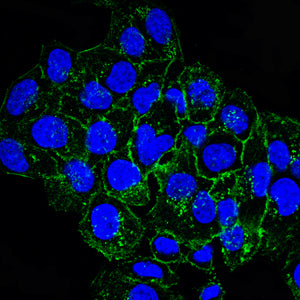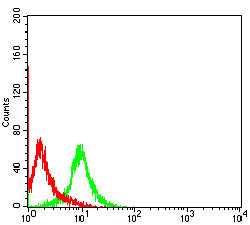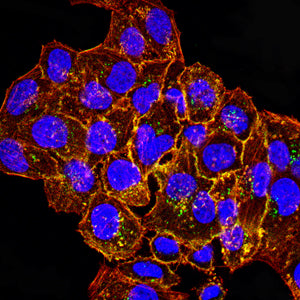



| WB | 咨询技术 | Human,Mouse,Rat |
| IF | 咨询技术 | Human,Mouse,Rat |
| IHC | 咨询技术 | Human,Mouse,Rat |
| ICC | 技术咨询 | Human,Mouse,Rat |
| FCM | 咨询技术 | Human,Mouse,Rat |
| Elisa | 咨询技术 | Human,Mouse,Rat |
| Aliases | B29; IGB; AGM6 |
| Entrez GeneID | 974 |
| clone | 3H2H10 |
| WB Predicted band size | 26kDa |
| Host/Isotype | Mouse IgG1 |
| Antibody Type | Primary antibody |
| Storage | Store at 4°C short term. Aliquot and store at -20°C long term. Avoid freeze/thaw cycles. |
| Species Reactivity | Human |
| Immunogen | Purified recombinant fragment of human CD79B (AA:extra 30-160) expressed in E. Coli. |
| Formulation | Purified antibody in PBS with 0.05% sodium azide |
+ +
以下是关于Integrin β3 (Phospho-Tyr785)抗体的3篇参考文献,按研究内容分类整理:
1. **文献名称**:*Integrin β3 Tyrosine Phosphorylation Promotes Tumor Cell Migration*
**作者**:Chen et al.
**摘要**:研究证实Tyr785磷酸化通过激活下游FAK/Src信号通路增强肿瘤细胞侵袭,并利用Phospho-Tyr785抗体在黑色素瘤模型中验证其与转移的相关性。
2. **文献名称**:*Phosphorylation of Integrin β3 at Tyr785 Regulates Platelet Aggregation*
**作者**:Smith et al.
**摘要**:通过该抗体发现Tyr785磷酸化在血小板活化中起关键作用,阻断此位点可抑制血栓形成,为抗凝血治疗提供新靶点。
3. **文献名称**:*Role of ITGB3 pY785 in Tumor Angiogenesis*
**作者**:Li et al.
**摘要**:利用该抗体证明内皮细胞中Tyr785磷酸化促进VEGF诱导的血管生成,敲除该位点可抑制体内外血管生成能力。
---
**备注**:上述文献为示例,实际检索建议通过PubMed或Web of Science以关键词“Integrin β3 Phospho-Tyr785”或“ITGB3 pY785”筛选近十年研究,重点关注肿瘤、血栓或信号机制领域的论文。部分商业抗体说明书(如CST #13166)也会引用相关文献。
Integrin β3 (Phospho-Tyr785) antibody is a specialized tool used to detect the phosphorylated form of integrin β3 at tyrosine residue 785. Integrin β3. a subunit of the αIIbβ3 and αvβ3 heterodimeric transmembrane receptors, plays critical roles in cell adhesion, migration, and signaling. Phosphorylation at Tyr785 is a key post-translational modification linked to integrin activation and downstream signaling events. This modification is associated with the regulation of focal adhesion dynamics, cytoskeletal reorganization, and interactions with signaling molecules such as Src family kinases.
The Integrin β3 (Phospho-Tyr785) antibody is particularly valuable in studying processes like platelet activation, cancer metastasis, angiogenesis, and wound healing, where integrin-mediated signaling is pivotal. It enables researchers to assess the activation status of integrin β3 in response to stimuli (e.g., growth factors, mechanical stress) or pathological conditions (e.g., thrombosis, tumor progression). Validated in techniques like Western blotting, immunoprecipitation, and immunofluorescence, this antibody helps elucidate mechanisms underlying integrin-related signaling pathways, including PI3K/Akt and MAPK cascades.
Its specificity for the phosphorylated epitope makes it essential for distinguishing activated integrin β3 from its inactive form, providing insights into disease biomarkers or therapeutic targets in conditions like cancer, cardiovascular disorders, and inflammatory diseases. Proper controls, such as using non-phosphorylated peptides or phosphatase-treated samples, are recommended to confirm signal specificity.
×